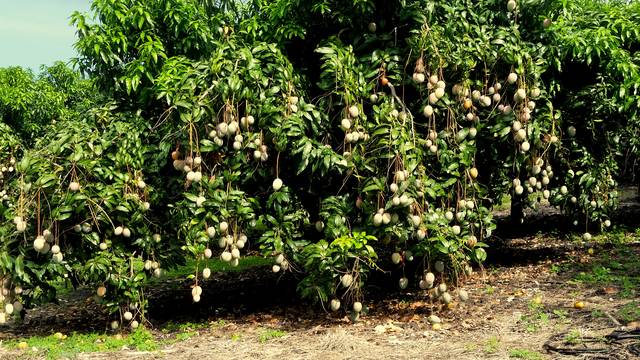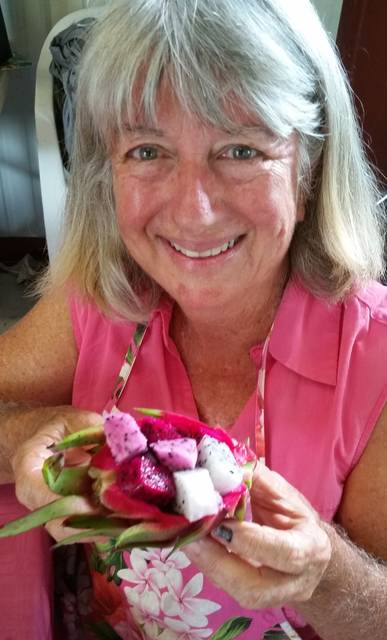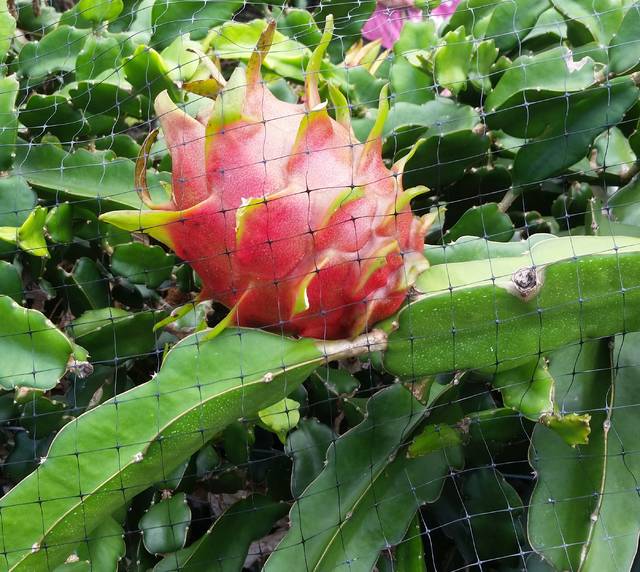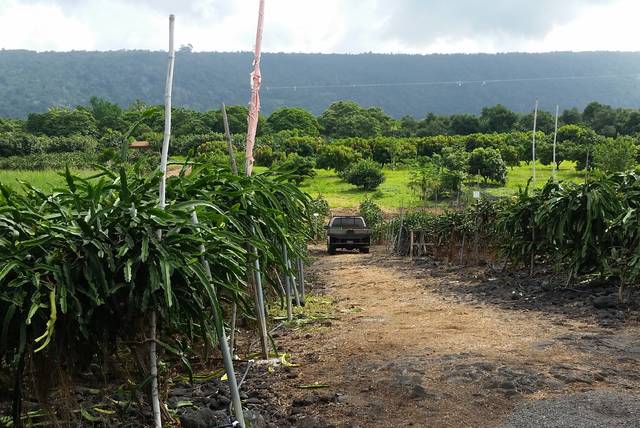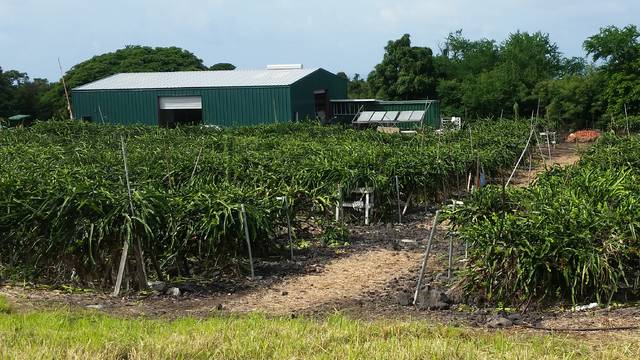The Weavers: Tropical fruit moguls
Susie and Terry Weaver met by chance at a party in Northern California in the early 1970s.
One of the first things they did together as a couple was plant a garden where they were living in Sonoma. This set the tone for decades of growing food. As a young couple in 1975, they moved to Guatemala where they spent six years learning about growing tropical fruit. It was in Central America that they first tasted mangos grown along the coast and dragon fruit grown at a mile high location. They fell in love with the flavors. Those appealing taste experiences determined their farming path for the future.
After leaving Guatemala in 1980, and before settling at their current farm, they spent a few years care-taking a macadamia nut and mango farm in South Kona and another few years on a couple acres in Waiohinu. There, they were able to plant their own mango trees for the first time. At every location, they also put in gardens and filled them with their favorite veggies.
“For us it’s always been about growing food,” said Susie, who went on to say that they always grow things they like to eat. “We look for good flavor in everything we grow.”
In 1993, after more than a decade of experience growing food in the tropics, Susie and Terry bought 5 acres in the Honaunau area. They built a house and moved there with their three children.
Of course, they planted mangos. They started with 15 different varieties, but were able to narrow it down to several favorites based on flavor, seasonal maturity and growth habits. In 2000, they purchased a neighboring 19 acres and today they grow hundreds of trees but only five varieties, including Golden Globe, Rapoza, Zillate, King Kona and Keitt. The Keitts ripen later than the others and on the day I visited the farm they were processing their Keitt harvest as well as three different varieties of dragon fruit.
All of the mango trees on the Weaver’s farm are grafted onto common mango root stock, planted in their rocky soil then mulched, fertilized and provided with drip irrigation lines. The trees are healthy and heavy-bearing. Growing the mangos is only part of the work, however. Terry and several workers do the harvesting. Then the fruit is taken into their large warehouse to prepare for market. Susie works alongside four or five helpers in the warehouse to wash, grade, sort and polish (yes, polish) the mangos before boxing them. Some of them go into their commercial kitchen for drying and packaging or for cubing into fresh fruit bowls to be sold at local markets. Terry then delivers many of the boxes himself to local stores, restaurants and distributers.
When they expanded their farm in 2000, they were able to start researching dragon fruit varieties suitable for their location at 500 feet in elevation. Their research connected them to dragon fruit growing locales around the globe. When they heard that professor Yosef Mizrahi, from Ben Gurion University in Israel, was giving a talk on dragon fruit on Oahu, they flew over to meet him.
That meeting opened up a relationship with Mizrahi that is ongoing. Each year after their harvest, they send a royalty to the agriculture department at Ben Gurion University of the Negev for research and development. Though most of the varieties arrived with accession numbers, the Weavers assigned English names to their favorites. Their large pink-fleshed one is called Jewel and the red one is named Venus. Today, they are the only U.S. farmers growing these Israeli varieties.
When Susie told professor Mizrahi’s wife, Nili that they wanted to name the white-fleshed variety after her, she wept saying, “Of all the plants Yosef has developed and named, he’s never named one after me. I am so touched and grateful for your honor.”
Her namesake lives on as one of Terry’s favorites with a soft texture and lychee-like flavor. All of the dragon fruit plants on the farm are grown on supportive trellises. Some are supported on wire fences while others grow on triangular “teepees.” According to Susie, the biggest challenge in growing dragon fruit is keeping the birds from eating the fruit. Currently, the cactus-like plants are all covered with netting to prevent bird damage and the problem is somewhat reduced. After many efforts to discourage the birds, they are still seeking an ideal solution.
When I asked Susie what part of the farming operation was her favorite, she replied, “Marketing. I love getting my fruit out into the community and am always trying to think of new ways to do that.”
She went on to tell me that she also loved receiving her water bill.
“Whenever I get the bill it reminds me how precious water is and how important it is to producing good crops. I actually love the reminder that comes with that bill,” Susie said.
Susie refers to farming as the school of hard knocks. They continue to learn as they go but it hasn’t been easy. Farming is simply hard work. The pair do enjoy everything they do, even though it often means 12-18 hours a day, especially during high season. For mangos and dragon, fruit the high harvesting season usually begins late in May and goes through November. During off season, Susie manages to get back to her kitchen garden and grow some of her favorite vegetables.
“Our farm is all about love,” she reports. “We love what we do, we love the people who work with us, we love growing food for our community and that’s why I put a little love in everything that goes out of here.” Look for the heart on her packaging that is an expression of her love.
In review, she notes that 40 years ago she never would have imagined she’d be managing 25 acres of tropical fruit one day.
“I never dreamed that I’d be, working with a great staff in a large warehouse and putting out thousands of pounds of food annually. You never know how your life will unfold, but growing what you love to eat can launch you into a wonderful world of joy. … At least it has for me.”
That joy is apparent in every box of tropical fruit that they deliver. The Weavers have figured out how to make farming an enriching life for themselves as well as for their community. Everybody wins.
Diana Duff is a plant adviser, educator and consultant living in a dryland forest north of Kailua-Kona.
Gardening Events
Thursday: “Women Farmers Workshop,” 9 a.m.-3:30 p.m. at DHHL Kuhio Hale, 64-756 Mamalahoa Highway in Waimea. Presentations and hands on workshops on various aspects of farming. Registration required for $12. To register, go to https://www.eventbrite.com/e/women-farmers-workshop-series-tickets-37112428272. Info: Visit https://oahurcd.org/womenfarmers.
“Hawaii Tropical Fruit Growers, Special Meeting,” potluck starts at 5 p.m. West Hawaii Tropical Fruit Growers office 81-6393 Mamalahoa Highway in Kealakekua. Peter Salleras from Queensland, Australia will talk about fruit trellising and “Bush Tucker” fruits. Vince Mina from Maui will talk about the recent Hawaii Farmer’s Union Convention. Info: Contact Brian Lievens President West Hawaii Chapter at 895-8753 or greenwizard@hawaii.rr.com.
Saturday: “Little Fire Ant ID Event,” 9 a.m.-1 p.m. at the West Hawaii Civic Center Hale. Sponsored by www.StopTheAnt.org. Set peanut butter covered sticks in suspected LFA areas for one hour. If ants arrive, bag them with stick and freeze. Bring frozen specimens for positive ID and advice. For more information watch the youtube at https://www.youtube.com/watch?v=mJ8TQ_ASsYQ or contact Carolyn Dillan at littlefireanthui@gmail.com.
“Work Day at Amy Greenwell Garden,” 9 a.m.-12:30 p.m. Meet at the Garden Visitor Center across from theManago Hotel in Captain Cook. Volunteers will be able to help with garden maintenance and are invited to bring a brownbag lunch. Water and snacks provided. Info: Call Peter at 323-3318.
Farmer Direct Markets
Wednesday: “Sunset Farmers Market,” 2-6 p.m. in the HPM parking lot, 74-5511 Luhia St., in Kailua-Kona
Wednesday and Friday: “Hooulu Farmers Market,” 9 a.m.-2 p.m. at Sheraton Kona Resort & Spa at Keauhou Bay
Friday: “Pure Kona Market,” 9 a.m.-5 p.m. at Amy Greenwell Garden in Captain Cook
Saturday: “Keauhou Farmers Market,” 8 a.m.-noon at Keauhou Shopping Center
“Kamuela Farmer’s Market,” 7 a.m.-noon at Pukalani Stables
Sunday: “Pure Kona Green Market,” 9 a.m.-2 p.m. at Amy Greenwell Garden in Captain Cook
Tuesday-Saturday: “U-Pick greens and produce,” 10 a.m.-4 p.m. at Tropical Edibles Nursery in Captain Cook
Plant Advice Lines
Anytime: konamg@ctahr.hawaii.edu
Tuesdays, Thursdays: 9 a.m.-noon at UH-CES in Kainaliu at 322-4892
Mondays, Tuesdays, Fridays: 9 a.m.-noon at UH-CES in Hilo at 981-5199 or himga@hawaii.edu


